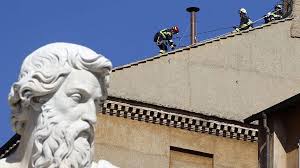
Vatican, May 7 – If the smoke is black, no new Pope has been elected. If it's white, a decision has been made: Habemus Papam—we have a Pope. It is a great event, broadcast live to millions of people.
But what TV viewers don't see is the hidden complexity of this centuries-old ritual: the carefully constructed chimney, the designed stove, and the precise chemical recipes, each part painstakingly designed to ensure a wisp of smoke conveys a clear message.
Experts explained that the process requires "two custom-made fireworks," smoke-testing rehearsals, and firefighters on alert.
Transparency
Pope Francis died on April 21, Easter Monday, at the age of 88. Once the funeral was over, attention turned to the conclave, a private meeting in which his successor will be elected.
The Vatican confirmed that the cardinals will gather in St. Peter's Basilica on May 7 for a special Mass before meeting in the Sistine Chapel, where the complex voting will begin.
The tradition of burning the cardinals' ballots dates back to the XV century and became part of the conclave rituals intended to ensure transparency and prevent manipulation, especially after delays in the papal election caused frustration and public unrest.
Over time, the Vatican began using smoke as a means of communication with the outside world, while preserving the strict confidentiality of the vote.
And today, despite countless advances in communication, the Vatican continues to preserve the tradition.
“Since ancient times, people have viewed rising smoke—from animal and grain sacrifices in the Bible, or from the burning of incense in tradition—as a form of human communication with the divine,” says Candida Moss, professor of theology at the University of Birmingham, United Kingdom.
“In the Catholic tradition, prayers 'ascend' to God. The use of smoke evokes these religious rituals and the aesthetic of awe and mystery that accompanies them.”
Moss also notes that the rising smoke allows people gathered in St. Peter's Square “to feel included, as if incorporated into this mysterious and secret affair.”
Complex Process
Inside the Sistine Chapel, two specific stoves are temporarily installed for the conclave: one to burn the ballots and another to generate smoke signals.
Both stoves are connected to a small duct - a tube inside a chimney that allows smoke to escape - that goes up the roof of the chapel to the outside.
Firefighters were recently seen on the roof, carefully securing the top of the chimney in place while workers set up scaffolding and built the stoves inside.
The Sistine Chapel, built more than 500 years ago, houses one of the most famous ceilings in the world. Adorned with Michelangelo's frescoes, it is not exactly designed for smoke signals, and the chimney must be installed discreetly and safely.
Technicians use an existing opening or create a temporary trapdoor through which the flue, usually made of a metal such as iron or steel, is inserted to allow the smoke to escape.
The pipe runs from the stoves to the outside, emerging through the tiled roof above St. Peter's Square.
Every joint is sealed to prevent leaks, and every component is tested.
Specialists rehearse with smoke in the days before the conclave begins, ensuring that the chimney draft works in real time. Even the Vatican firefighters participate, on alert in case there is a breakdown.
"It's a very precise process, because if something goes wrong, it's not just a technical failure, it becomes an international incident," Kevin Farlam, a structural engineer who has worked on heritage buildings, told the BBC. "It's not like putting a pipe in a pizza oven. Every part of the system has to be installed without damaging anything."
This assembly is built days before the cardinals' arrival and dismantled once the Pope is elected.
To make the signal visible, Vatican technicians use a combination of chemical compounds.
“In essence, what they are building here are two bespoke fireworks,” Professor Mark Lorch, head of the chemistry and biochemistry department at the University of Hull, UK, explains to the BBC.
“For the black smoke, a mixture of potassium perchlorate, anthracene, and sulfur is burned, producing a thick and dark smoke.
“For the white smoke, a combination of potassium chlorate, lactose, and pine rosin is used, which burns cleanly and palely.
“In the past, attempts were made to burn wet straw to create a darker smoke and dry straw to make a lighter smoke—but this caused some confusion because it sometimes looked gray.”
Lorch says these chemicals are “pre-packaged in cartridges and ignited electronically,” so there is no ambiguity.
The bell ringing—introduced during the election of Pope Benedict XVI—now serves as confirmation and is used alongside the smoke signal.
Over the years, proposals have been made to modernize the system: colored lights, digital alerts, or even televised voting.
But for the Vatican, the ritual is not just a communication tool: it is a moment of continuity with centuries of tradition.
“It's about tradition and secrecy, but it also has real theological weight,” says Moss.
“Furthermore, 'Catholic Church' and 'avant-garde' are far from synonymous: innovation is almost antithetical to ritual.” (Text and Photo: Cubadebate)